How to visit Athens and avoid the Acropolis crowds
The crumbling relics of the Greek capital are ancient history. Give them a miss and discover an exciting new side to the city.
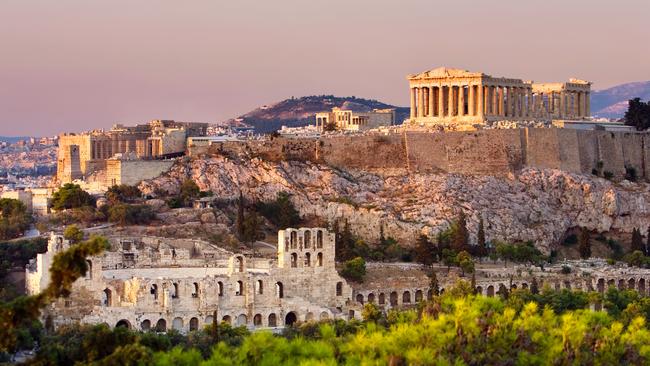
“It’s easy to tell the art galleries apart from the brothels,” explains Athenian curator Alkistis Tsampouraki, when she first directs me to The Breeder, a pioneer venue in the up-and-coming neighbourhood of Metaxourgio. The hottest bohemian event of the evening, a reception for a local artist, is about to get under way. The Breeder has neither a sign nor a street number but Tsampouraki keeps her directions simple. “The brothels are the ones with lamps over the doors.” It’s a handy tip, as in much of downtown Athens, Metaxourgio includes Parisian-style cafes, elegant boutiques and leafy outdoor restaurants cheek by jowl with the grittier elements of urban life.
Along the quiet pedestrian Iasonos St, I pass several neoclassical mansions that are burnt-out, abandoned and covered in graffiti, including statements in ancient Greek, such as “Art for art’s sake”, plus the odd community “guerrilla garden”. I can’t help but notice the red lamps glowing over almost every doorway. But Tsampouraki has assured me the louche location is excellent for art. “The brothel owners are very friendly; we all get along very well,” she insists. “They keep order in the street and make sure there is no one spray-painting the gallery walls.”
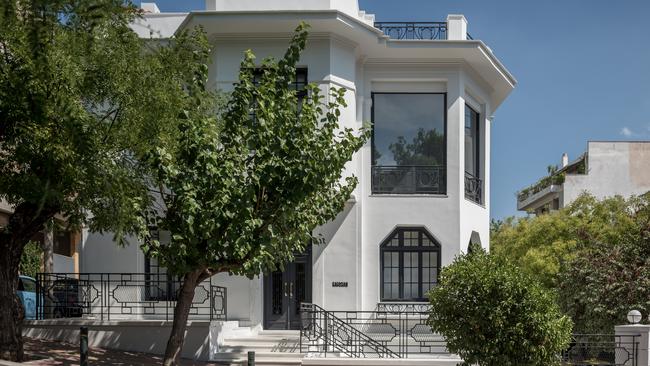
And indeed, The Breeder, set in a renovated ice-cream factory from the 1970s, is heralded by a sleek, spotless white facade. I shoulder open a vast iron portal as thick as a bank vault door, which swivels on an axis to reveal a regal interior with two levels of organic curves, rather like a mini-New York Guggenheim. A crowd of hip Athenians sip white Moschofilero wine as they admire the work of Aristeidis Lappas, who’s created a giant portrait of the Minotaur, the mythical half-man, half-bull that lived in the Labyrinth of Crete and demanded the sacrifice of Athenian youths and maidens. But Lappas has made his subject colourful, friendly-looking and surrounded by forests. “I’m trying to transform the symbol,” he explains. “Picasso used the Minotaur as a symbol of aggressive masculinity, but Minoan culture was matriarchal, and this bull is very gentle.”
An art reception in Athens is quite different from, say, New York or Paris. On the street, trestle tables are laid out end to end. When seated, I’m introduced to a small army of exuberant Athenian artists while lamb kebabs are roasted on a charcoal grill, filling the air with a delicious scent. Soon a hole-in-the-wall kafenia, or bar-cafe, starts serving plump olives, tzatziki (yoghurt with garlic), spanakopita (spinach pie) and grilled chicken with lemon.
Tsampouraki is one of many Athenian expats who returned during the pandemic and helped transform the capital into a flourishing cultural centre, despite challenges that would have crushed lesser cities. Greece is still reeling from the economic crisis that began in 2008. But the hard times also have had their benefits for artists, including studio spaces for the equivalent of $400 a month and $5 jugs of delicious wine at every corner.
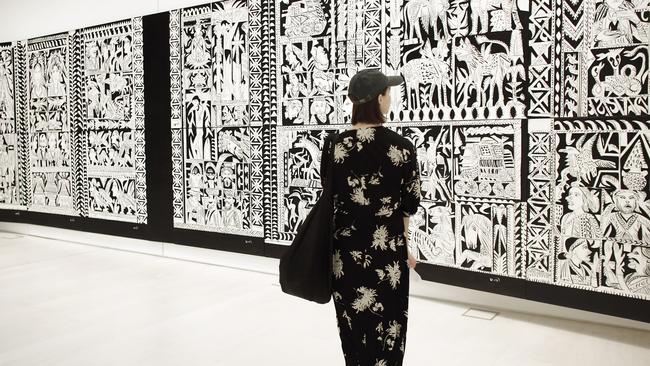
The contemporary art scene in Athens was given its first burst of attention when it co-hosted Documenta in 2017 alongside its traditional home, Kassel in Germany. The word soon spread. Thanks to the cheap rents and abundance of semi-derelict urban spaces, artists soon began descending from across Europe in droves, while new art galleries and museums sprouted in such numbers that in 2020 the London Financial Times hailed Athens as Europe’s hotspot under the giddy headline “An Art Capital Rises”. The use of abandoned warehouses and factories by artists inspired the international media catchphrase “Athens is the new Berlin”, a cliche Athenians hate, in part because the austerity cuts demanded by Germany in the EU’s rescue package of 2010 were considered by Greeks brutal, provoking violent demonstrations. Most Greeks prefer a phrase daubed by the graffiti artist known as Cacao Rocks: ATHENS IS THE NEW ATHENS.
The pleasant art evening is an eye-opener for me, too. I first visited Athens years ago to research my two books on the classical Greek world, Pagan Holiday and The Naked Olympics. Back then, I was forced to agree with the general verdict on the city as a traffic-jammed and wearying mess to be passed through rapidly en route to Aegean beaches. But the 2004 Athens Olympics brought new highways, a metro system and pedestrian-only streets, all making the city more liveable, even downright charming. On this trip, I decide to pay little heed to its famous ancient ruins. I won’t even climb the Acropolis, but instead concentrate on the flourishing modern city.
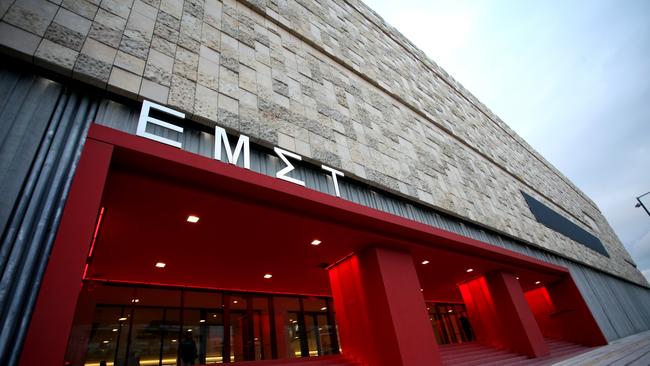
GET YOUR CULTURE FIX
To anyone who knew the down-at-heel “old Athens”, the range of innovative venues feels like science-fiction. Apart from scrappy outposts such as The Breeder, the blue-chip Gagosian, a branch of the New York gallery, opened in 2021 in a palatial mansion in the upscale neighbourhood of Kolonaki. That same year saw the opening of the National Museum of Contemporary Art in a grandiose multi-level structure, placing Greek artists within the context of cutting-edge work from Europe, the US and Asia. Many of the most striking images on display relate to the current refugee crisis.
An arts foundation called NEON creates provocative temporary exhibitions in venues all over the city, including (often) a spectacular complex in a cavernous former tobacco factory. True to the group’s name, the stone walls of its covered courtyard were recently tattooed with words in blue neon, each a variation on two lines by the beloved Greek-Egyptian poet Cavafy, from his 1903 master work, Waiting for the Barbarians. (One version read: “Now what are we going to do without the barbarians? Those people were a kind of solution.”)
Even just walking the streets of Athens is an aesthetic adventure, since the boom in graffiti art has turned the city into an open-air canvas, particularly in Metaxourgio. Images range from an enormous portrait of Solon, the ancient Athenian lawgiver, to overtly political images, like a black-and-white painting of the Mona Lisa’s eyes in which her pupils reflect an image of a policeman raising a baton and shifty-looking politicians.
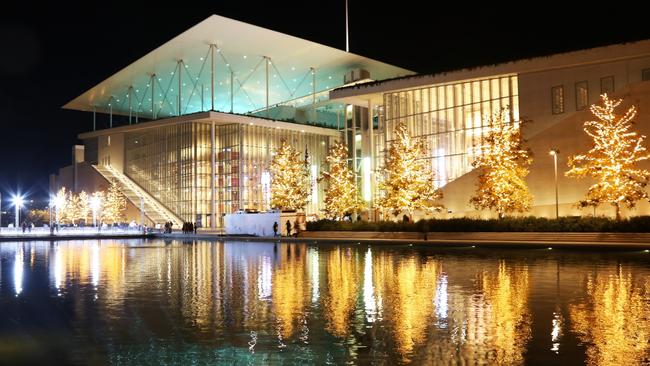
A 15-minute taxi ride from downtown is the astonishing Stavros Niarchos Foundation Cultural Centre, a complex of white structures that loom in Egyptian splendour over extensive olive groves and a lake with choreographed “dancing fountains”. It has a gorgeous opera theatre, avant-garde performance spaces, a library and cafe. An array of celebrations occurred for the 2023 centenary of the birth of the great Greek opera diva Maria Callas, whose angelic voice, extravagant romantic life and mysterious death once captivated the world. The Maria Callas Museum, opened last October in a neoclassical mansion on centrally located Mitropoleos St, displays her personal artefacts, costumes and performance recordings.
Finally, one of the most uniquely Athenian cultural excursions is to take another short taxi from Stavros Niarchos (or 20 minutes from downtown) to the feisty industrial port district of Piraeus. A trio of avant-garde art galleries has opened on a back street called Polidefkous, in between working machinery shops and dusty hardware stores selling propellers and pipes. Each one is hidden in a splendid stone warehouse that soars like a capitalist cathedral. The pioneer, Rodeo, recently displayed marvellous work by a Greek artist who physically painted underwater, using his own specially designed oils, to create lush and abstract images. Afterwards, repair to another warehouse virtually next door that has been turned into the Paleo Wine Store, with tables spilling on the sidewalk, where you can dine on seafood and choose between three dozen fine bottles of Greek wine, all open and ready to sample. It’s the perfect Athenian package.
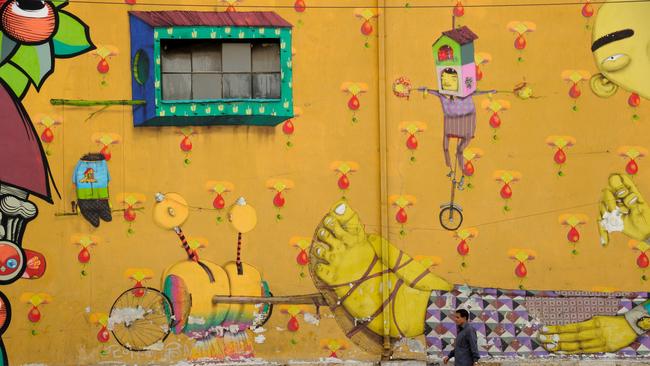
WHERE TO EAT
Wine is Fine: This oddly named venue is among the most entertaining new spots in the city; no reservations are taken at the French-owned Greek-Italian bar-restaurant, but turn up to the pedestrian street intersection at 7pm where tables are laid out beside closed stores for excellent Aegean wines and delicious, affordable pasta. When tables fill up, the corner turns into a packed street party on weekend nights. The location is at Vissis 6 in the Monastiraki downtown district. Dinner daily from 6pm.
Isandsia: The hottest new fine-dining restaurant in Athens is a “new-age taverna” set in a sleek minimalist space with outdoor tables on a charming laneway. The lemon-suffused twists on classic Greek seafood dishes are wildly creative.
@Isansia
Pharaoh: Already a natural wine mecca for Athenians, Pharoah is a happening bar-restaurant with DJs spinning records right next to the blazing wood-fired kitchen stoves, where the chefs are whipping up delicious Greek dishes.

Latraac: The neighbourhood-in-transition Metaxourio has a lovely square called Avdi Place surrounded by outdoor cafes and restaurants with creative use of space. One half-ruined, roofless mansion has been repurposed as a courtyard to house a gourmet food truck with painted barrels for tables; look for the Galiantra sign. Afterwards, head a block away to eccentric Latraac Skate Cafe and Bar, a joint with its own skateboard bowl, which sounds like a dangerous combination, but is definitely a “scene”.
The Clumsies: This quirky cocktail lounge is regularly in the World’s Top 50 Bars list. Set in a cosy antique townhouse, its famed Aegean Negroni has the fluorescent turquoise glow of the ocean, mixing the bar’s own artisanal gin with extract of fennel and such exotic Greek liqueurs as Diktamo, all garnished with a fresh lime leaf.
Diporto: Head for this classic taverna hidden in the basement near the Monastiraki markets, reached via an unmarked trapdoor. Dating from 1875, the subterranean site was, according to legend, an ancient wine bar in the days of Plato. Today, it is crowded with wooden barrels and rickety tables around a charred oven, where tin pots of food burble on gas burners. White-haired owner-chef Dimitris doles out plates of grilled sardines, bowls of Greek ratatouille and metal tubs of Moschofilero wine, for about $10 a head; Socratous 9.
Nolan: The city’s first (but no longer only) Japanese-Greek restaurant takes the renowned local seafood to mouthwatering new levels amid chic decor only a stone’s throw from busy Syntagma Square.
nolanverse.com
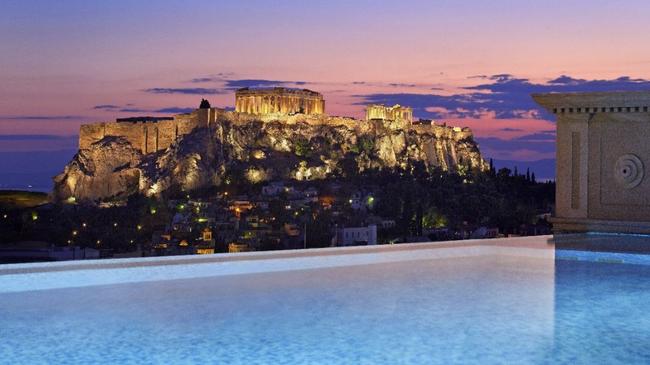
WHERE TO STAY
Mona Hotel: This coolest of recent openings is located in a superbly renovated textile factory from the 1950s in the bustling antiques and market area of Monastiraki. Its industrial-chic aesthetic is Brooklyn-meets-Aegean, with postmodern furniture set against raw concrete walls and polished stone floors. The rooftop is an ideal sun-dappled spot to enjoy a sumptuous breakfast of Greek pastries, coffee, yoghurt and fresh fruit with suitably astonishing views of the Acropolis crowned by the Parthenon. Once a month, it’s also the setting for arty social club gatherings, called Club Monamour.
The Dolli: This most anticipated opening of 2023 is a luxurious option located in a renovated neoclassical structure a stone’s throw from the ancient Temple of the Winds. The lobby is filled with ancient and contemporary artworks, although the most unforgettable sight might just be the rooftop infinity pool, where the floodlit Parthenon is reflected in the shimmering waters, a startling collision of classical and modern.
thedolli.com
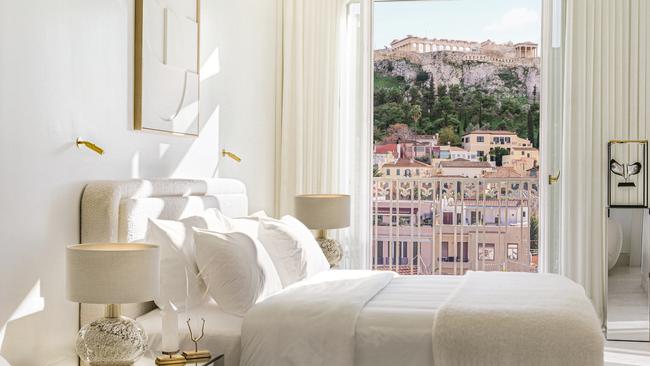
Moxy Athens City: Expect reasonable tariffs, a colourful, almost nightclub-style vibe of plentiful neon and splashy art, and a prime location on the central Omonia Square. Breakfast service is fast and cheerful, and there’s a metro station entrance right at the front door.
marriott.com
Grande Bretagne Hotel: This neoclassical pile has been the favoured base for visiting Hellenophiles since its opening in 1874, when the city of 5000 inhabitants was barely larger than a village. The landmark still rises like a marble-filled temple over Syntagma Square. Its gilt-filled spaces are adorned with 19th-century engravings, and from balcony-category rooms guests can watch the Sunday changing of the guard outside the Hellenic Parliament. Even if you’re not staying it’s worth a visit to take in the Acropolis views over a drink at the rooftop bar.
If you love to travel, sign up to our free weekly Travel + Luxury newsletter here.





To join the conversation, please log in. Don't have an account? Register
Join the conversation, you are commenting as Logout